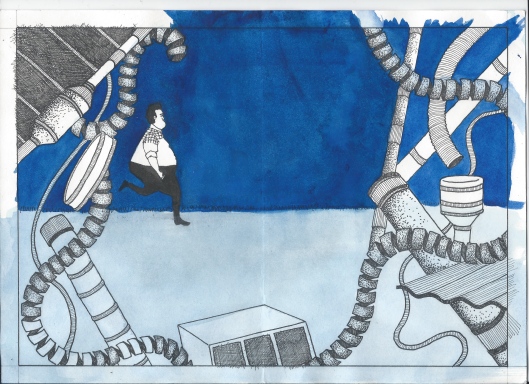Finally Done!
02 Friday Jan 2015
Posted in Uncategorized
02 Friday Jan 2015
Posted in Uncategorized
02 Friday Jan 2015
Posted in Uncategorized
I wasn’t very happy with the style and wanted to add more line detailing to the frames. Also the water colours and brush work didn’t give the spreads the finish I was aiming for. 
I decided to add more pen detailing and work with a combination of water colour and digital colouring.
I felt that the rabbit trail being red didn’t suit the mood of lingering I was trying to establish in the comic, and decided to switch to a more subtle yellow.
02 Friday Jan 2015
Posted in Uncategorized
16 Tuesday Dec 2014
Posted in Uncategorized
16 Tuesday Dec 2014
Posted in Uncategorized
The Metro scrapyard is a vast plot of land strewn with every conceivable kind of scrap. Navigating through the vast scrapyard is rather like exploring an industrial wasteland, with rows of towering piles of sand or junk.
I decided to use the scrapyard as the site for my second narrative. In this story the caretaker’s daily routine is interrupted by a sudden glimpse of the strange rabbit. Unsure of what he has seen and whether it is real, the caretaker decided to follow the rabbit.
16 Tuesday Dec 2014
Posted by taarikajohn | Filed under Uncategorized
27 Monday Oct 2014
Posted in Uncategorized
Tags
Abandoned Plot, Character Exploration, Comic book, Creating narrative, Feedback, Illustration Style, Ksana - Finding Interludes, Namma Metro, Peenya, Peenya Industrial Area
While reflecting on the feedback received after the exhibition and contemplating the way forward, I was taken aback at how much had changed since I had written my project proposal. I became increasingly apprehensive about whether the map of the abandoned plot was indeed a “map.”
I referred to my project proposal and the definition of map I had included which described a map as “a symbolic depiction highlighting the relationship between elements of some space.” This was an appropriate description of my map for the plot but the project as a whole still had a lot of loose ends to tie up.
I consulted Amitabh and we discussed the possibilities of maps and narratives in other spaces we had explored and documented in Peenya. We agreed that the form of map and comic complimented each other in the telling of a narrative of the space. The comic for the abandoned plot needs to be reworked and given more structure to better tell its story.
We also decided to maintain the characters of the caretaker and the rabbit and the interaction between them. The caretaker’s persistent conflict of whether the rabbit was real or imaginary posed itself as an interesting tool to narrate stories within chosen spaces, thereby providing the audience a lens through which to perceive each space.
I created a few iterations of each character before deciding on the aesthetic of the final characters.
27 Monday Oct 2014
Posted in Uncategorized
The exhibition provided an opportunity for us to present our work-in-progress to the public and our colleagues and faculty. Feedback at this stage was immensely helpful, letting us step back from our projects to examine our process critically with the eyes of a stranger.
Alison liked the use of shifting viewpoints as transitions and that the story was not dependent on language. She wanted to know if it were to become a series, and asked me how I see the project in the space and what methods of replenishment and distribution I would use. She also suggested creating titles that were symbolic, making the project entirely independent of language.
Narendra urged me to explore a form other than a book and mentioned that the illustrative possibilities of a large space get lost in the small book format. He added that if I wanted to maintain the book form to consider the idea and form of the metro and its usual aesthetics to be translated into the book, story and style.
17 Friday Oct 2014
Posted in Uncategorized
17 Friday Oct 2014
Tags
Abandoned Plot, Bangalore, Comic book, Creating narrative, Illustration Style, Ksana - Finding Interludes, Mapping, Namma Metro, Peenya
Posted by taarikajohn | Filed under Uncategorized